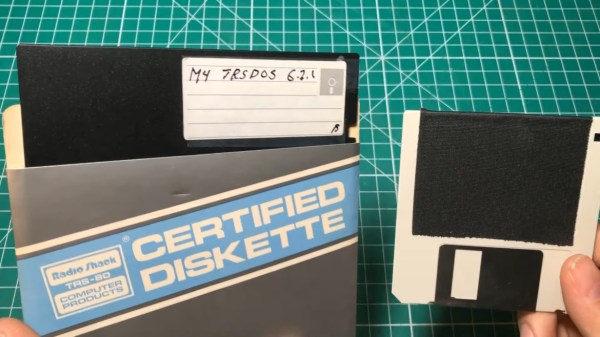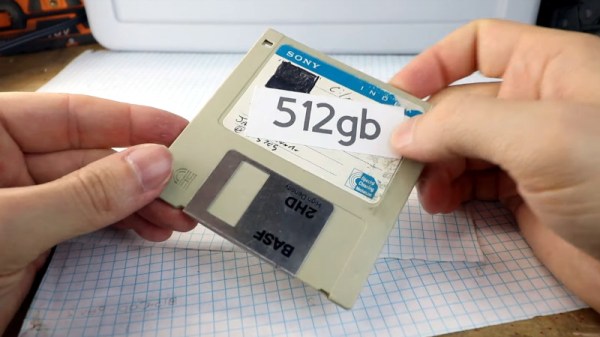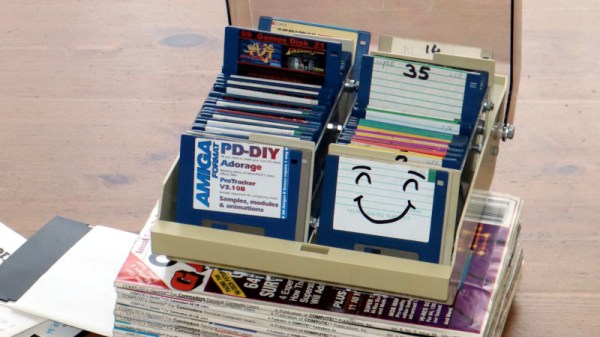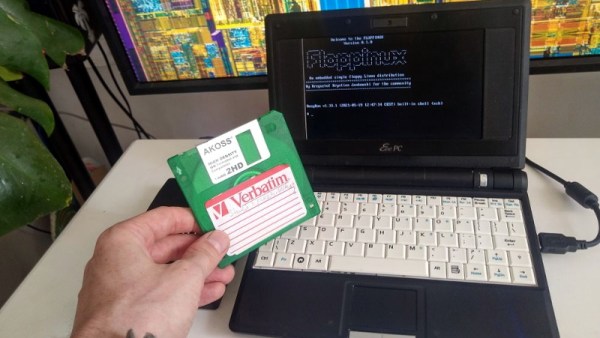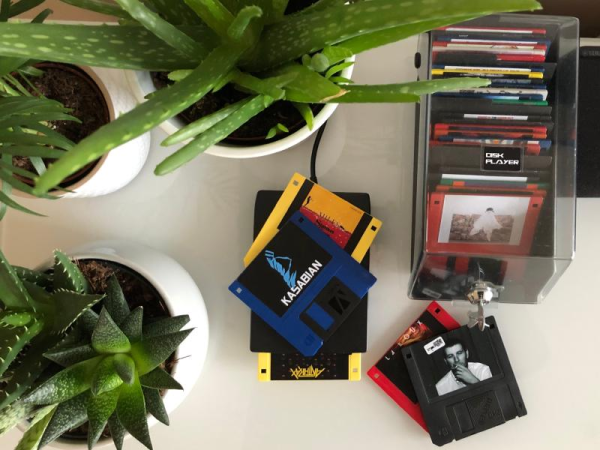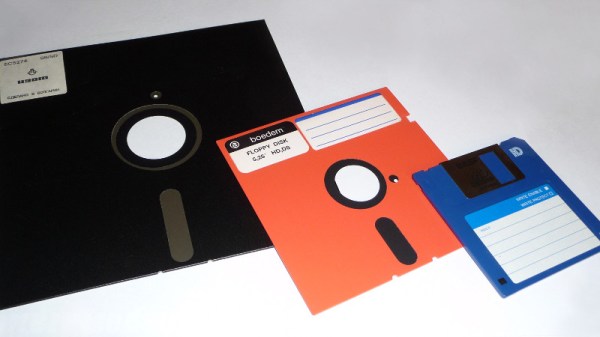Ahh, floppy disks. Few things carry nostalgia quite like a floppy — either 3 1⁄2 or 5 1⁄4, depending on which generation of hacker you happen to be. (And yes, we hear you grey-beards, 8-inch floppies were definitely a thing.) The real goodies aren’t the floppies themselves, but what they carried, like Wolfenstein 3d, Commander Keen, DOS, or any number of other classics from the past. Unfortunately a bunch of floppy disks these aren’t carrying anything anymore, as bit rot eventually catches up with them. Even worse, on some trashed floppies, a format operation fails, too. Surely, these floppies are destined for the trash, right?
Continue reading “Magnetic Maniac Manages Mangled Memory”
3.5″ floppy disk Articles
The 512 Gigabyte Floppy Disk
There are times when a technology goes almost overnight as if in a puff of smoke, and others when they fade away gradually over time to the point at which their passing is barely noticed. So it is with removable media, while we still have the occasional USB flash disk or SD card , they do not come anywhere near the floppies, Zip disks, and CD-ROMs of the past in their numbers or ubiquity. If the floppy disk is just a save icon to you there’s still the chance to experience their retro charm though, courtesy of [Franklinstein]. He’s made a 3.5″ floppy disk that eschews 720 k, 1.44 M, or even 2.88 Mb, and goes all the way with a claimed 512 Gb capacity. We’re sure we can’t remember these from back in the day!
Of course as we can see in the video below he’s achieved neither an astounding feat of data compression nor a bleeding-edge method of storing bits in individual iron oxide molecules. Instead the floppy hinges open, and there’s a holder for micro SD cards where the disk itself would be. It’s a bit of fun, and we have to agree with him that it makes a very handy holder for micro SDs that can carry that much data. This sets us wondering though, whether it would be possible to somehow multiplex 14 micro SDs to a microcontroller on a PCB that could fit in a floppy shell. Perhaps an ESP32 could be a slow file server through a web interface?
He makes the point that 512 Gb of floppies would comfortably exceed the height of the tallest buildings were they stacked together, so at the very least this represents a space saving. If you’re looking for something slightly more functional and don’t mind modifying the drive, there’s always this classic approach to marrying a floppy with an SD card.
It’s Always Floppy Time!
On [Jan Derogee]’s desk is something that wouldn’t look out of place for many of us, a pile of computer magazines with a case of 3.5″ floppy disks on top of it. The causal observer would see nothing more than the detritus of a retrocomputer enthusiast’s existence, but stick around. In fact it’s a clock, and one of the most unusual ones we’ve seen in a long time.
How can a box of floppies tell us the time? Selected disks have custom labels that look as though they might be authentic game collections, but in reality are fakes that carry numbers alongside the game art. An ingenious system of cams hidden in the hollowed out pile of magazines raises the correct floppies to tell the time, hours on the left row and minutes to the closest five minutes on the right. The floppies are modified by the removal of some plastic and the disk itself, because early versions had a habit of shredding disks. A final touch comes in the form of a Nokia phone on the desk next to the clock which plays a tune in lieu of chimes on the hour. You can see the clock in action in the video below the break.
Running Modern Linux From A Single Floppy Disk
There was a time when booting Linux from a floppy disk was the norm, but of course, those days are long gone. Even if you still had a working 3.5 inch drive, surely the size of the modern kernel alone would far exceed the 1.44 MB capacity of the disks, to say nothing of all the support software required to create a usable operating system. Well that’s what we thought, anyway.
But then [Krzysztof Krystian Jankowski] dropped Floppinux, a live Linux OS that boots from just a single floppy. There’s even a few hundred KB left over on the disk, allowing the user to tuck a few of their own programs and scripts onboard before booting it up. But most impressively, the project doesn’t rely on ancient software releases like so many other embedded systems do. Every component of Floppinux is pulled directly from the cutting edge, including version 5.13.0-rc2 of the Linux kernel which is literally just a few days old.
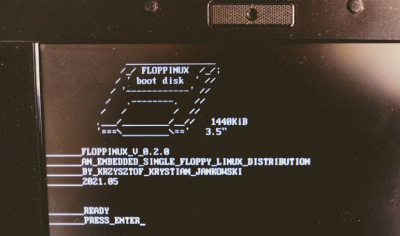
Of course some concessions had to made in order cram the latest Linux kernel and build of BusyBox into slightly north of 1 MB, so Floppinux certainly isn’t what anyone would call a daily driver. The kernel is stripped down the absolute minimum, and is targeted for the decidedly poky i486. [Krzysztof] had to be very selective about which programs actually made the cut as well, so once the system is booted, there’s not a whole lot you can do with it outside of writing some shell scripts. But then, that was sort of the goal to begin with.
If you’re wondering how [Krzysztof] pulled it off, you don’t have to. He walks you though the entire process, down to the commands he used to do everything from pull down and compile the source code to creating the final disk image. Even if you don’t own a floppy drive, it’s well worth following his guide and booting the image up in QEMU just to say you’ve officially built a Linux system from scratch. It’s good for more than just bragging rights; learning how all the components of a minimal install like this fits together will no doubt come in handy the next time you find yourself poking around inside an embedded Linux device.
The Floppy Disk As A Portable Music Format
We remember the floppy disk as the storage medium most of us used two decades or more ago, limited in capacity and susceptible to data loss. It found its way into a few unexpected uses such as Sony’s Mavica line of digital cameras, but outside those who maintain and use older equipment it’s now ancient history.
Seemingly not for [Terence Eden] though, who has made a portable audio player that uses a floppy disk as its storage medium. It came about with the realization that half an hour of extremely compressed audio could be squeezed onto a standard 3.5 inch floppy, and then that the Beatles’ A Hard Day’s Night album comes in at only a shade over that time. With some nifty manipulation of the compression command line and the judicious removal of some unnecessary metadata, the album can fit on a floppy in equivalent quality to the AM radio fans would have heard it over back in 1964.
The player would have been a major undertaking when the floppy was king, but in 2020 it’s simply a USB floppy drive, a Raspberry Pi, and a battery pack. He’s given us the full instructions, and no doubt a more permanent version could be built with a 3D-printed case.
We’re fascinated by the recent trend of storing audio on floppy disks, but despite the hipster vibe, we doubt the idea will catch on. It’s not the first floppy-based player we’ve seen, but the previous one was more of a fake player.
Music Player Erected From Floppy Disks
Holding on to a cache of old floppies because nostalgia? Us too, and this might be the coolest possible use for ’em. While it’s fun to imagine that he wrote a compression algorithm to fit a lossless copy of Coltrane’s Blue Train on a 1.44Mb coaster, or somehow rolled his own mini-disc, [Dino Fizzotti]’s Diskplayer uses floppies to serve up Spotify albums.
What’s actually on the floppy, then? The corresponding Spotify album URL. He just pops a disk in the drive, and the Pi does the rest — it detects the floppy event and executes a script that starts an open-source Spotify client. There’s no track skipping and no shuffle, just the entire album as intended, take it or eject it. If you think about it, he’s actually managed to improve on the vinyl experience, since all the songs are on one side. Demo is queued up after the break, and it includes [Dino]’s simple web interface for writing the Spoti-floppies.
When this project started seven months ago, [Dino] intended to bring his vinyl collection into the 21st century with RFID tags, but we’re glad that he decided to involve a fairly obsolete medium. Don’t have a drive or a heap of floppies gathering dust in a closet? Neither did [Dino]. But he found plenty of people selling pretty-colored floppies on ebay, and Amazon has tons of cheap external drives. We think the album art stickers are a nice touch, as is matching album cover color to floppy. He’s right to lock those bad boys up.
Got a bunch of floppy drives? Build a Floppotron and make your own music!
Retrotechtacular: The Floppy Disk Orphaned By Linux
About a week ago, Linus Torvalds made a software commit which has an air about it of the end of an era. The code in question contains a few patches to the driver for native floppy disc controllers. What makes it worthy of note is that he remarks that the floppy driver is now orphaned. Its maintainer no longer has working floppy hardware upon which to test the software, and Linus remarks that “I think the driver can be considered pretty much dead from an actual hardware standpoint“, though he does point out that active support remains for USB floppy drives.
It’s a very reasonable view to have arrived at because outside the realm of retrocomputing the physical rather than virtual floppy disk has all but disappeared. It’s well over a decade since they ceased to be fitted to desktop and laptop computers, and where once they were a staple of any office they now exist only in the “save” icon on your wordprocessor. The floppy is dead, and has been for a long time.
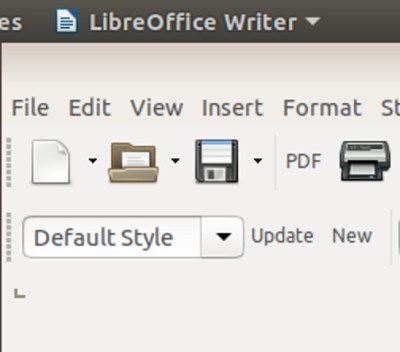
Still, Linus’ quiet announcement comes as a minor jolt to anyone of A Certain Age for whom the floppy disk and the computer were once inseparable. When your digital life resided not in your phone or on the cloud but in a plastic box of floppies, those disks meant something. There was a social impact to the floppy as well as a technological one, they were a physical token that could contain your treasured ephemeral possessions, a modern-day keepsake locket for the digital age. We may have stopped using them over a decade ago, but somehow they are still a part of our computing DNA.
So while for some of you the Retrotechtacular series is about rare and unusual technology from years past, it’s time to take a look at something ubiquitous that we all think we know. Where did the floppy disk come from, where is it still with us, and aside from that save icon what legacies has it bestowed upon us?
Continue reading “Retrotechtacular: The Floppy Disk Orphaned By Linux”

